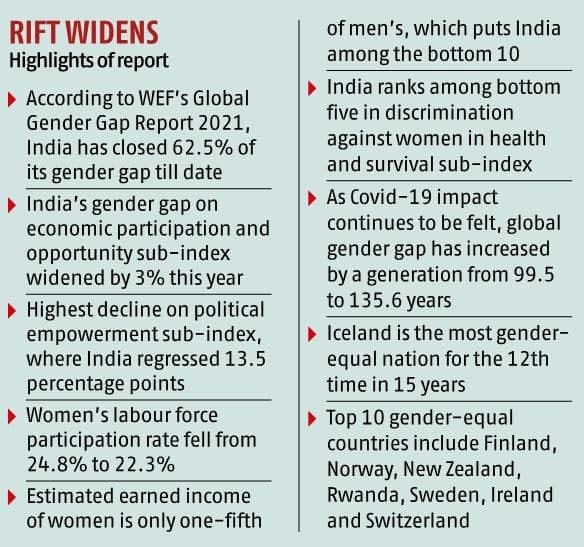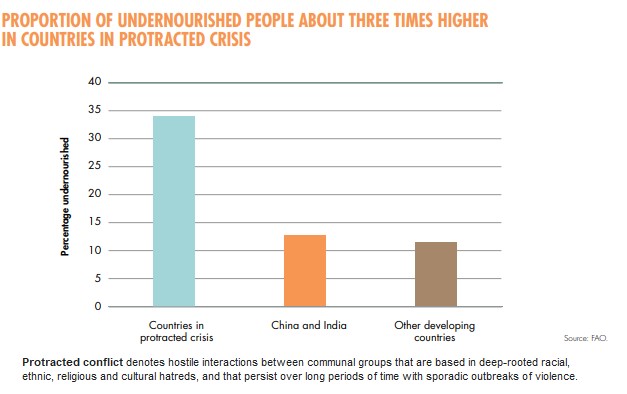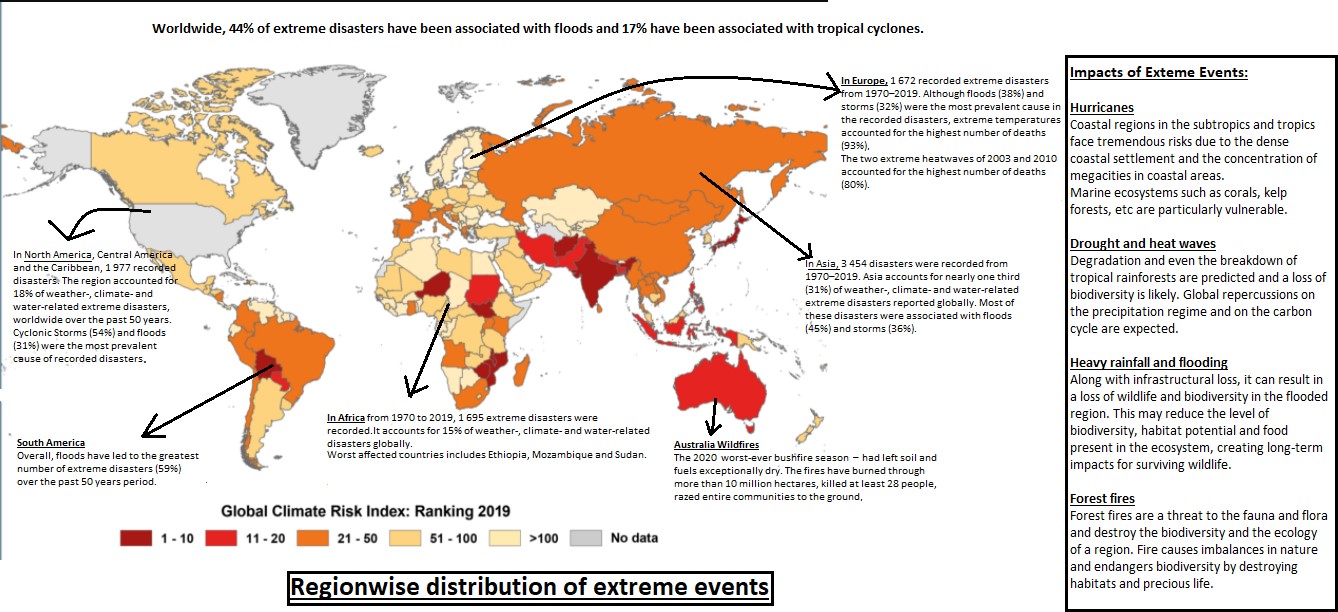11 Dec
Declining employment rates- need for employment policy in India
In News
Introduction
- There is evidence that countries are moving away from tackling employment issues solely through the use of active labour market policies such as direct job creation and providing subsidies to generate employment. They are moving towards development and adopting comprehensive national employment policies,bringing together various sectoral measures, programmes and institutions that influence the dynamic demand and supply of labour and the functioning of the labour market responding to the short, medium- and long-term prospects and priorities.
- As the Indian economy grows, the standard of living of its labour force, estimated to be around 500 million, will increase. This labour force is part of the global supply value chain and acquires a greater role because there is a phenomenon of "race to the bottom" in terms of costs. China’s experience shows thatwages have been increasing there, in recent years, which is giving India an edge. When we talk of India, these dynamics and international benchmarks, we need to come out with a dedicated National Employment Policy (NEP), vis-à-vis other competitive countries.
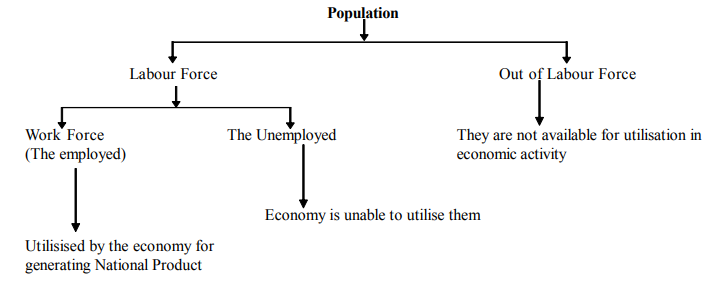
Declining employment rates – An Analysis
- India’s employment rate has been falling steadily as shown in the graph. The slide in the employment rate continues. As of February 2021 it dropped even further to 37.7%. The rate has recovered from the steep fall earlier in fiscal 2020-21. But it has merely reverted to its trend of a steady fall that was established before the lockdown.
- Employment in the industry declined from 3.3 million in 2017-18 to 2.3 million in 2018-19 and then to 1.8 million in 2019-20. Employment had inched up to 2 million in May-June 2021 but was down again to around 1.8 million by September 2021.
- Employment in September 2021 is estimated at 406.2 million. This is the highest in 20 months or since the Covid-19 shock in March 2020. It is, however, still lower than the pre-Covid employment of 408.9 million in 2019-20. It is also slightly lower than the September 2019 employment level of 406.7 million.
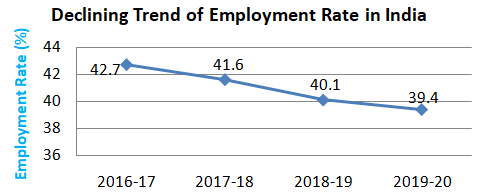
Employment Planning in India

The Geography of Employment
Based on Census 2011 data following spatial pattern emerges in terms of quality and quantity of jobs.Districts with a relatively high share of regular jobs were clustered in the extreme south, and in a narrow strip extending along the western coastline across the country till the extreme north.
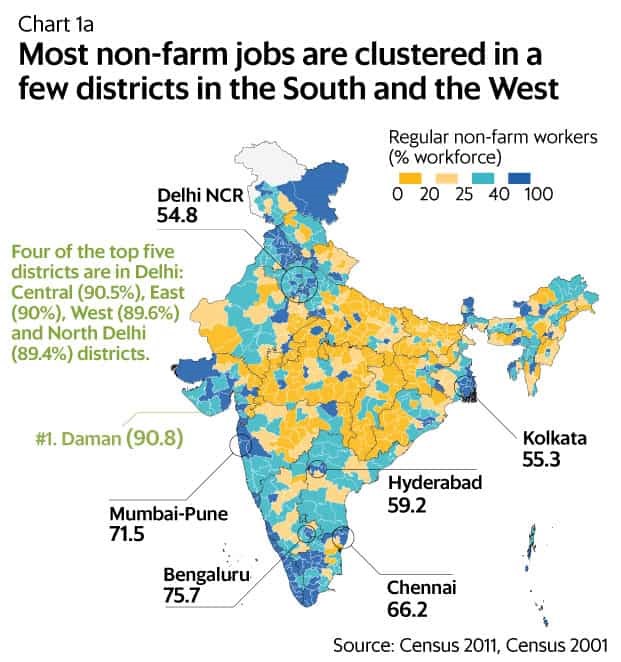
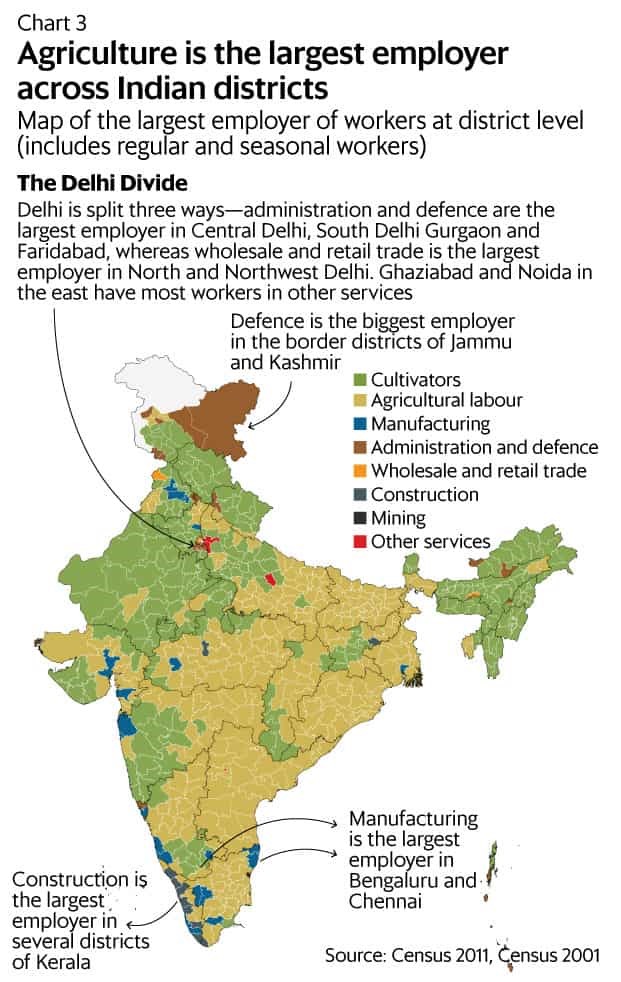
Most districts in some of India’s most youthful and populous states, such as Bihar, Uttar Pradesh and Madhya Pradesh, witnessed either a decline or stasis in the share of regular jobs between 2001 and 2011. These are the districts where the demand for jobs is the greatest, and where regular jobs are increasingly difficult to find.
One big reason for the lack of much progress in creating regular non-farm jobs lies in India’s failure in manufacturing. Barely 26 of the 640 districts in 2011 had more than a fifth of their workforce employed in manufacturing. Most districts across the country actually saw the share of regular manufacturing workers fall between 2001 and 2011.
Regular jobs here refer to those workers in the 15-59 age group who worked in a job for more than six months in a year, and who were classified as ‘main workers’ by the census.
Critical Issues necessitating the need for an NEP
The country is currently undergoing a dual challenge of employment creation. One set of people are the unemployed labour force (i.e. highest in last 45 years, 6.1 per cent in 2017-18) and, another set are around 10 million new entrants in the labour force every year. In this backdrop following are the key issues that demand a full- fledged employment policy.
- Huge Informal Employment:A majority of India’s workforce (460 million) is engaged in informal work that is not covered by any social security benefits and, more likely, not even earning the minimum wage. Roughly nine out of 10 workers are informally employed and lack any social protection. This creates a huge transformation problem from a largely informal to a formal economy.
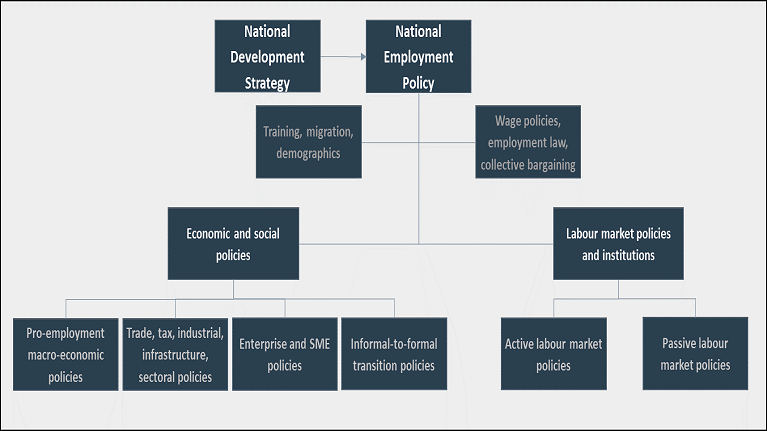
- Rising Open Unemployment:India’s open unemployment has increased manifold and reached its highest level of 6.1% in 2017-18, followed by a marginal decline, 5.8% in 2018-19. In particular, the unemployment among educated and women is very hig This will likely go up substantially further after the COVID-19 pandemic. As estimated by the Centre for Monitoring Indian Economy (CMIE), the unemployment rate touched as high as 24% in May, 2020. In particular, the youth unemployment is substantially higher than other age-groups thus failing to reap the benefits of demographic dividend.
- Low Female Workforce Participation Rate:The female work participation rate is just 18.6% in 2018-19 compared to 55.6% of their male counterparts. There are many arguments put forth such as social norms, larger involvement in household responsibilities, increase in households’ income, more participation in higher education and unavailability of suitable jobs. Given the relative absence of job opportunities, women, especially the urban educated, have been discouraged from entering the labour market.
- Lack of Structural Transformation and Underemployment: Around half of India’s workforce is still employed in agriculture for their livelihood, which contribute just less than a fifth of the national income. Due to the unavailability of enough jobs in non-agriculture sectors, most people in rural areas are still engaged in farm activities. In addition, most of the workers in informal sector work at low wages. Underemployment, that is, too few hours of work per week available for an average employed person along with low wages with full-time job, is a huge problem.
- Low Productive and Low-Quality Job:Only around 24% workers are engaged in regular jobs, which are considered better quality jobs compared to self-employed and casual labour. Further, the disproportionately high informal sector employment is a major problem in India.
- The decent new employment created in the country has not been high. Almost half of all new non-agricultural jobs added in India during the second half of the 2000s was in one sector, construction, which is characterized by relatively low wages and poor working conditions.
- Since quality formal employment is rare in India, access to regular jobs is highly unequal among social groups, and across regions.
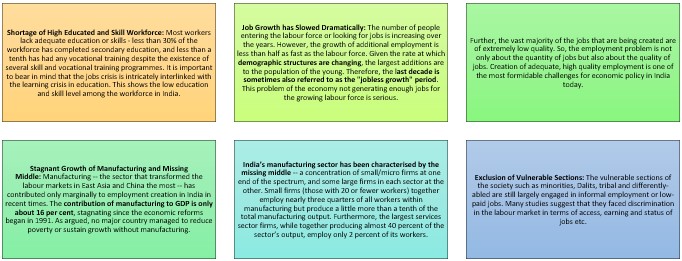
- Multiple Labour laws and Regulations:There are over 200 state laws and close to 50 central laws. And yet there is no set definition of “labour laws” in the country. India is in the midst of reforming its labour regulations with codification of labour laws into four labour codes. Also, some states have relaxed the decades-old labour laws in recent times to woo investments in their respective regions as they fight economic downturn due to the COVID-19.
- Threat of Automation:The technological advancement is posing a threat of automation or robotisation substituting human workers with robots. As research studies show that one industrial robot can replace six workers, in the case of India up to 52% of the activities can be automated having the greatest impact on low-skilled jobs and simple assembly tasks.
- New Emerging Jobs:The new emerging gig economy or freelance jobs, which are temporary and flexible and considered as independent contractor. The people involved in such jobs are not considered as an employee or workers and also not covered by any national labour laws. In addition, these emerging jobs are also not counted in the national statistical system.
- COVID-19, Employment and Livelihood

Therefore, recognizing these challenges and putting in place appropriate policy responses to tackle them is of utmost priority. As multiple forces, ranging from technological advances to climate change to demographic changes transform the world of work, the absence of decisive policy action will further disrupt livelihoods and exacerbate inequalities. The government needs to take appropriate steps urgently to assess the current employment situation in the country, including the macroeconomic environment, demographic context and sectoral challenges in employment generation, following which it should set targets and monitor them.
Where it can be used:
- Geography Optional P1 – Quality of Life, Population as a Resource, Optimum Population, Worker- population Ratio
- Geography P2 – Population Geography, Regional Development, Contemporary issues
- GS P3 – Economy
- Essay on related topics
Source:
- Need for a National Employment Policy
- EMPLOYMENT (VISION 2020)
- EMPLOYMENT AND UNEMPLOYMENT: POLICY IMPLICATIONS
- Employment Situation in India
- National Employment Policies
- The grim reality hidden by recent decline in unemployment rates
- The geography of employment in 21st century India
- The geography of core employment
- Employment Generation and Inclusive Growth in the BRICS – An ILO perspective
- Employment increases by 8.5 million
- Return to a declining gradient
Threatened Coastal Lifeline- Mangroves
- In news: Maharashtra to study role of mangroves in serving as buffer against cyclones.
Background:
- Mangroves are a variety of species of broad-leaved trees (10–40 feet high) lying in muddy creeks and tidal estuaries. They are located on the intermediate zone between the land and the sea and represent one of the best examples of ecotone.They require warm saline water and so they are situated along tropical coastlines.
- It grows along coastlines, taking root in salty sediments, often underwater.
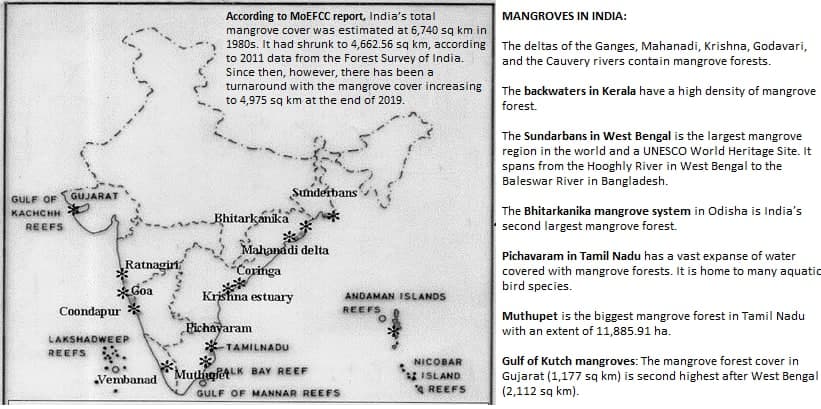
- How are Mangroves- the coastal lifeline threatened:
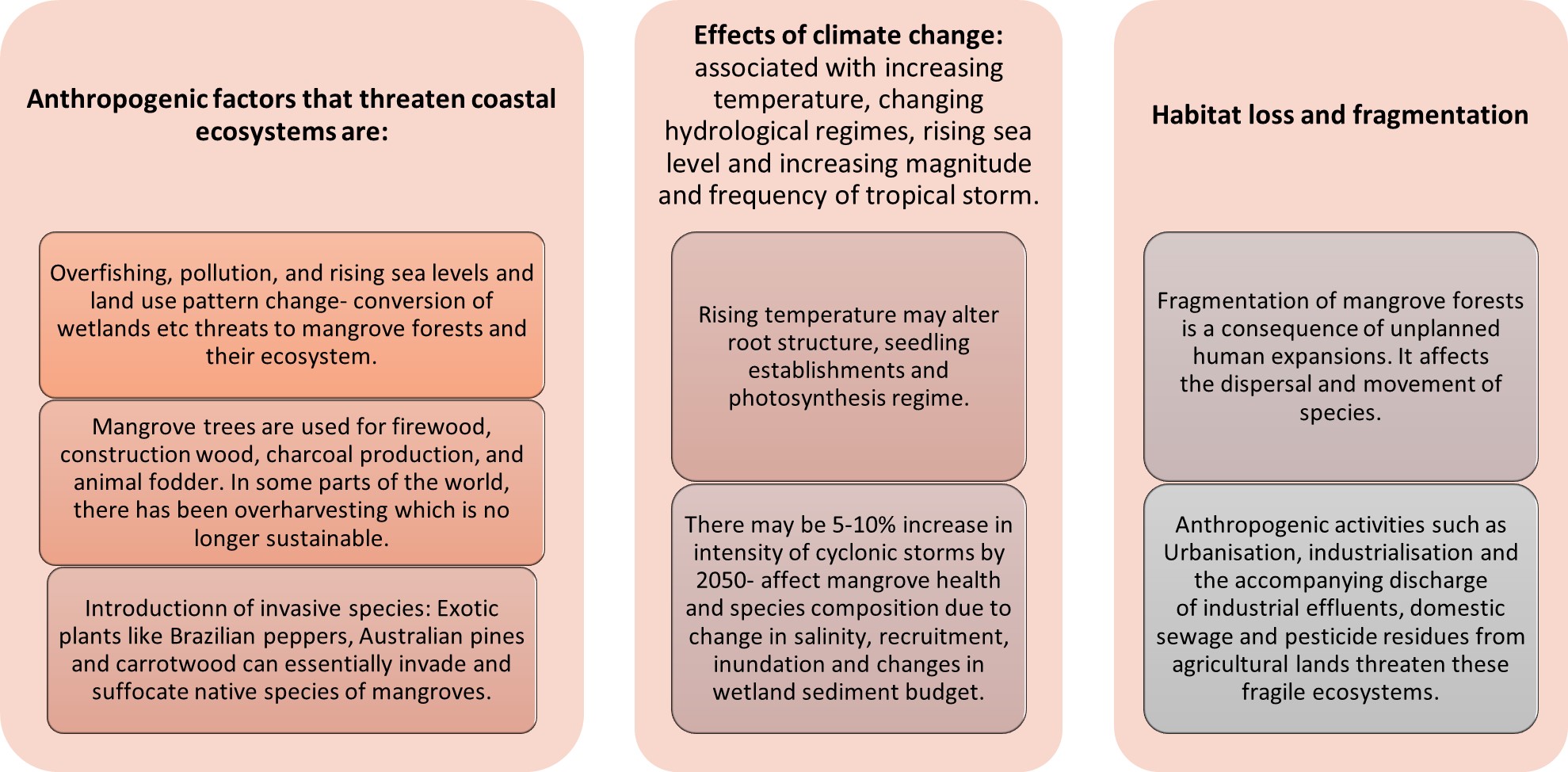
Case study: Bhitarkanika mangrove forest, Odisha
It has the second-largest mangrove forest in India and is a Ramsar site- a notified Ramsar wetland — is spread over 195 sq. km and is home to 62 mangrove species. The dense mangrove cover in Bhitarkanika has dropped over the years.
- In 2002, it stood at 122 sq km.
- By 2020, it dropped to 101 sq km, reporting a 14% decline.
Around 307 villages having 1.5 lakh people depend for fuel, fodder and other non-timber forest produce from the Bhitarkanika mangrove ecosystem.
The loss of mangrove of Bhitarkanika is mainly due to human encroachment and reclamation of land for agriculture and unsustainable resources use practices such as aquaculture activities.
Also recent development activities such as construction of jetties, roads and the proposal of a major port at Dhamra threaten the existence of this ecosystem.
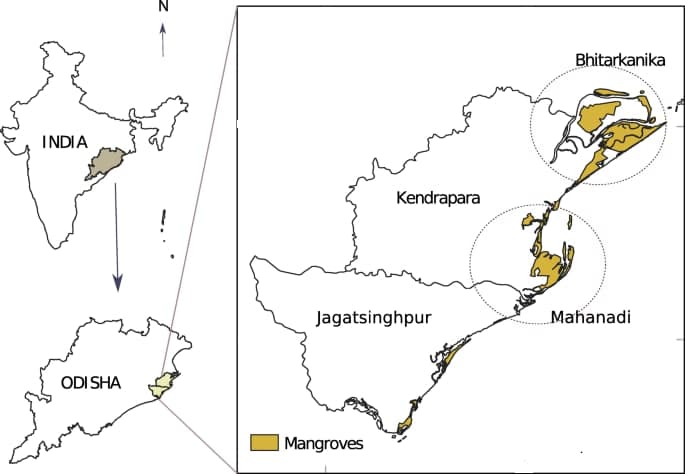
- Strategies to save coastal mangroves:
- Agro-forestry along the periphery of mangroves in the wastelands can be taken up for providing alternate fodder to the cattle of nearby villages.
- Protection of species and habitat: identify and protect critical areas, species, and also source of seeds to ensure restoration following disasters.
- Management of man-made pressure:
- Coastal industries and private owners need to be persuaded to actively participate in protecting and developing mangrove biodiversity.
- The participation of the local community should be made compulsory for conservation and management.
- Establishments of green belts and buffer zones: for coastal protection from erosion and to provide transition between human inhabitation and natural environment either landward or seaward.
- Ecosystem restoration of mangroves:

Examples: Beekeeping, aquaculture, mangrove eco-tourism.
UNESCO has also undertaken several initiatives to support the conservation of mangroves. While inclusion of mangrove forests in the list of Biosphere Reserves, UNESCO Global Geo-parks, and World Heritage sites have improved management and conservation.
- Where we can use it:
- Geography: P1 (Biogeography and Environment) and P2(Resources).
- GS: PIII (Conservation, Environmental Pollution and Degradation, Environmental Impact Assessment).
Links:
- International Day for the Conservation of the Mangrove Ecosystem: Not just a lifeline for coastal communities
- community-created mangrove forest protects a village from eroding away
- Twin benefits of mangrove plantation in Sundarbans: building resilience to climate change and supporting rural livelihood
- Scientific management of mangroves is need of the hour
- Importance of mangrove forests in India
Polavaram Project- A Solution Or A Challenge?
Why in news: SC to study Odisha’s plea against NGT order accepting the recommendations of a committee on a range of issues concerning the Polavaram project.
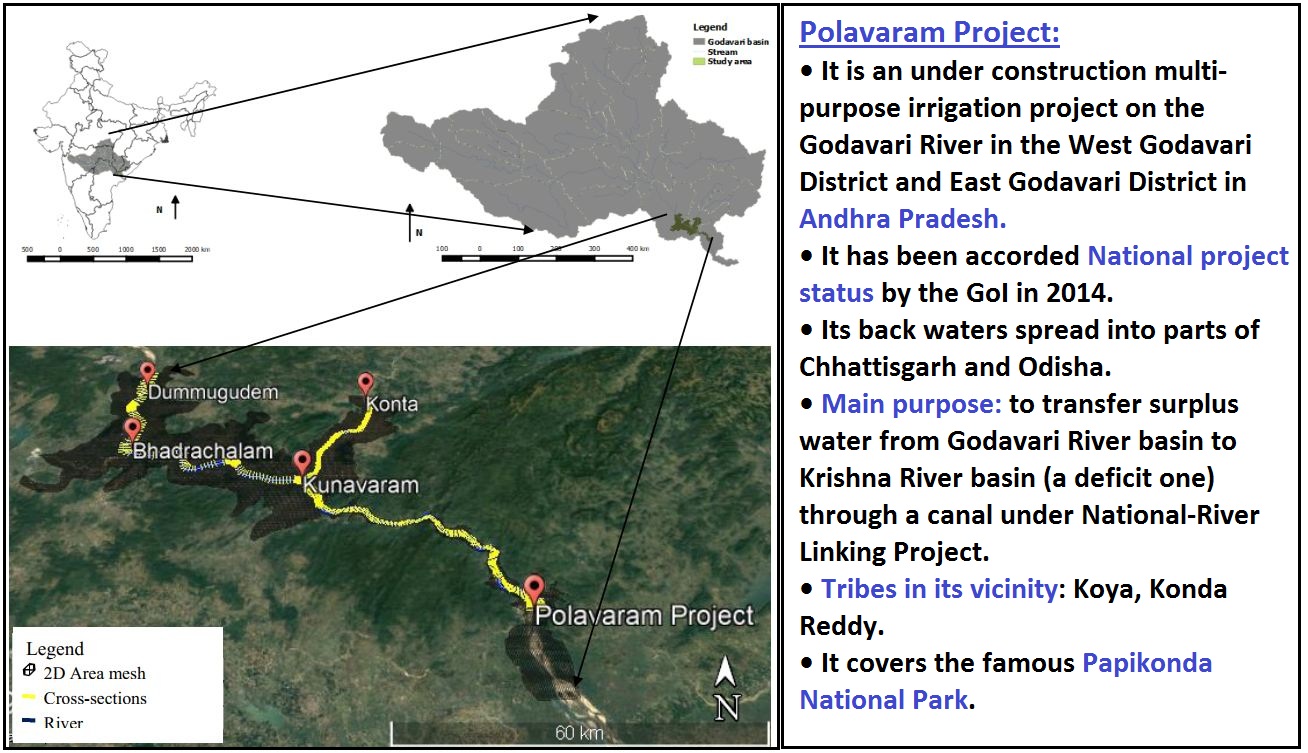
Potential benefits from the Polavaram Project:
- Irrigation: According to the documents relating to the Polavaram project, 291,000 ha of new land will be brought under irrigation—129,000 ha by right canal and 162,000 ha by the left canal.
- River linking: The project is expected to divert 80 TMC water from the Godavari basin to the Krishna Delta. This river linking will benefit all the 13 districts of A.P, directly and indirectly. If executed well, this project can make the state drought-free forever.
- Hydro power: Hydropower potential of the Polavaram project will be around 960 MW.
Challenges associated with the Polavaram Project:
- Duplicate irrigation: International Water Management Institute based in Sri Lanka that studied the Krishna-Godavari river link found that 95 per cent of the areas to be irrigated by the Polavaram dam through the right canal were already irrigated; the rest five per cent areas were not under cultivation. The government has already built several lift irrigation projects parallel to the canals—Tadipudi, Pushkharam and Chagalnadu —that will irrigate around 75% of the total area supposed to be irrigated by the Polavaram project. In effect, the Polavaram dam may irrigate only 25% of new land.
- Largest displacement ever: The project, set to be operationalized by April 2022, will displace the largest number of people in India’s history of such projects. Once completed it will uproot about 1 lakh families across 222 villages in Andhra Pradesh. The backwaters might also displace about 3,000 families in Odisha and Chhattisgarh. For every five acres that will be irrigated by the project, one tribal family will be displaced.
- Improper rehabilitation: While a little over 6,000 families have rehabilitated so far, the modus operandi till now clearly foreshadows a humanitarian crisis. The National Commission for Scheduled Tribes observed that the rehabilitation colonies lacked basic amenities like drainage systems, drinking water, roads, sanitation, etc. The commission had also noted that the houses constructed in many tribal colonies leaked at the ceiling and that walls had cracks.
- Design plays down flood threat: Environmental clearance for the Polavaram dam is based on a 2005 EIA. But the Central Water Commission (CWC) changed its flood situation estimate in 2006 which has not been incorporated in the design.
- Unsafe embankments: The project will submerge villages along the Sabari River in Konta block of Chhattisgarh’s Dantewada district. In Odisha, villages along the Sabari and Sileru rivers (tributaries of the Godavari) in Motu block will be submerged. Andhra Pradesh has suggested constructing 30.2-km-long protective walls in Odisha and 29.12-km-long walls in Chhattisgarh to avoid But there have been no assessments to gauge the maximum flood level that would impact the embankments.
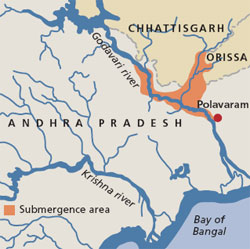
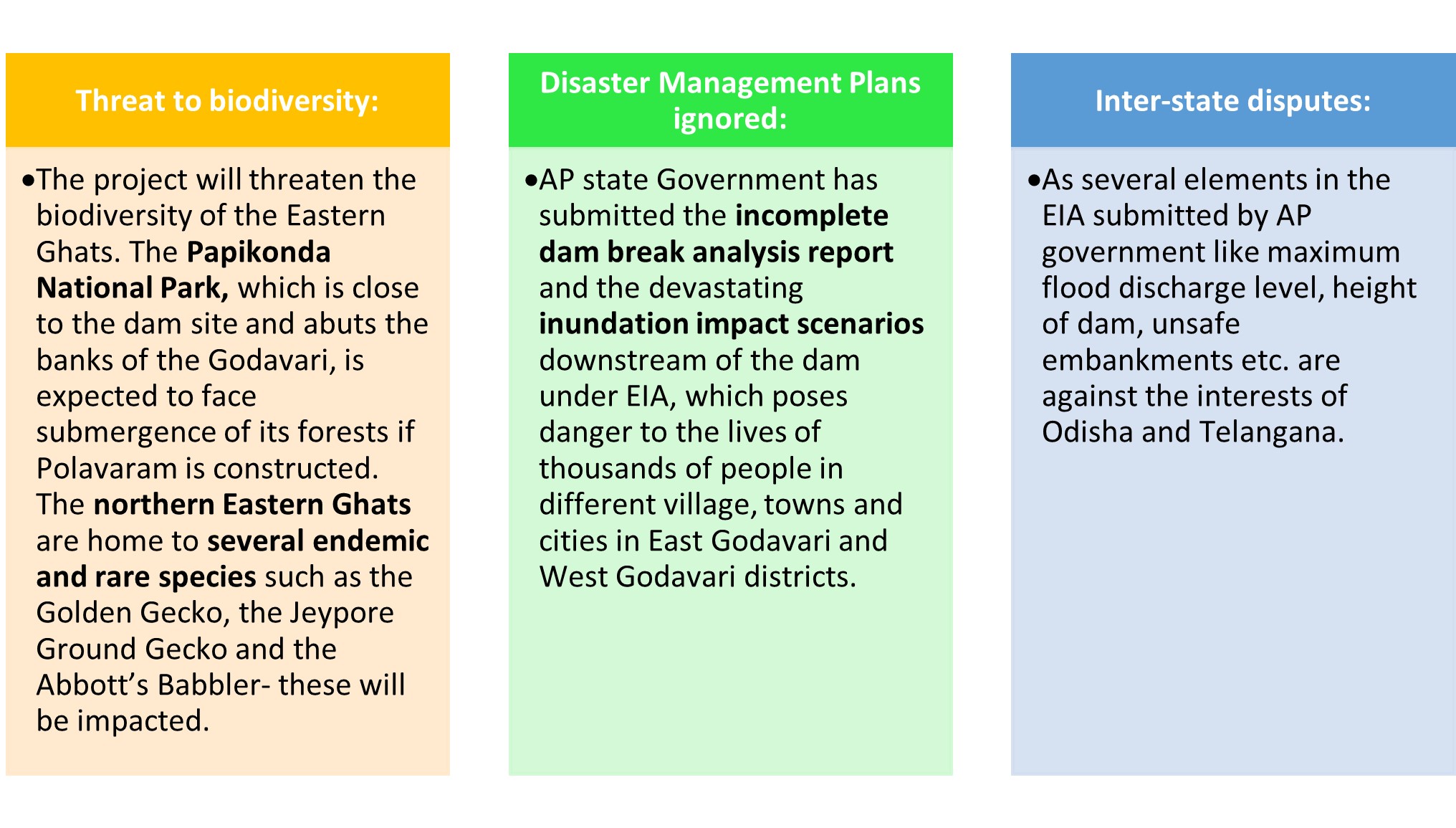
With challenges out playing the benefits and cost-benefit analysis being against the project, several experts arguing for alternative options to Polavaram project like constructing more number of small-hydro projects so as to avoid adverse impacts and highlighting for the need to invest in technologies that lead to improvements in productivity rather than expanding the area under irrigation.
Where it can be used?
It can be used in topics related to Paper 1 (Biodiversity, Environmental management) Paper 2 (Drainage System, Floods and Droughts, Environmental Impact Assessment).
Sources:
- Polavaram — displaced and nowhere to go: Rehabilitation colonies are unlivable
- Polavaram project: SC to study Odisha’s plea against NGT order
- Why Polavaram is a pointless project
- Polavaram--solution or problem?
- Barrages would prevent Polavaram dam from being an economic and environmental disaster : Analysis reveal
Ecosystem-based Adaptation
Ecosystem-based Adaptation (EbA) is a nature-based solution that harnesses biodiversity and ecosystem services to reduce vulnerability and build resilience to climate change.
For example - coastal habitat restoration using mangroves, agroforestry, integrated water resource management, livelihood diversification, and sustainable forest management interventions that use nature to reduce vulnerability to climate change.
Key Features
- EbA uses the sustainable management, conservation, and restoration of ecosystems to provide services that enable people to adapt to the impacts of climate change.
- It is a people-centric concept, but one that acknowledges that human resilience depends critically on healthy ecosystems.
- Integrated into an overall adaptation strategy, EbA provides sustainable and cost-effective solutions for people affected by climate change.
- EbA is a policy mix that integrates development and environmental policies.
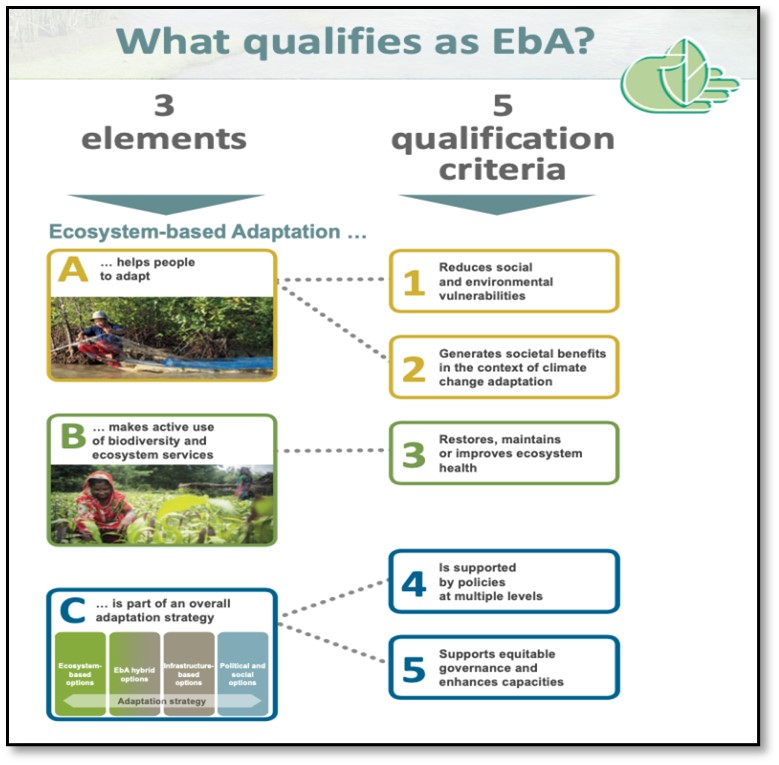

Sources:
Integrated Child Development Services (ICDS) Scheme
Launched on 2nd October, 1975, the Integrated Child Development Services (ICDS) Scheme is one of the flagship programmes of the Government of India. As a response to the challenge of providing pre-school non-formal education on one hand and breaking the vicious cycle of malnutrition, morbidity, reduced learning capacity and mortality on the other. The beneficiaries under the Scheme are children in the age group of 0-6 years, pregnant women and lactating mothers.
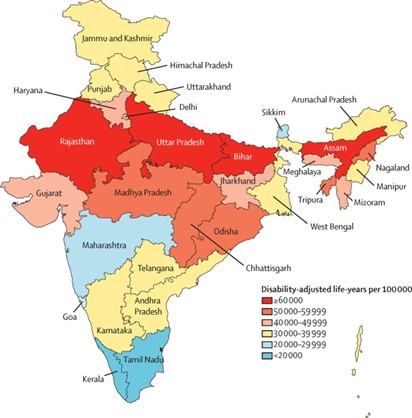
Map 1 - Disability-adjusted life-years rate attributable to malnutrition in Children younger than 5 years of age in the states of India, 2017
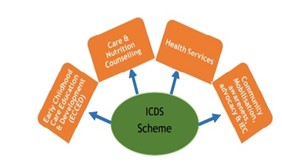
Fig1: Services offered under ICDS
Objectives of the Scheme are:
- To reduce the incidence of mortality, morbidity, malnutrition and school dropout;
- To lay the foundation for proper psychological, physical and social development of the child;
- To achieve effective co-ordination of policy and implementation amongst the various departments to promote child development; and
- To enhance the capability of the mother to look after the normal health and nutritional needs of the child through proper nutrition and health education.
According to NFHS-5, Infant and child mortality rates across most Indian states have declined. Child nutrition indicators showed a mixed pattern across states. While the situation improved in many States and Union Territories, there has been minor deterioration in others. This depicts the success of programmes like ICDS.
Piedmont glaciers
A piedmont glacier is a valley glacier which has spilled out onto relatively flat plains, spreading into bulb-like lobes. The formation of a piedmont glacier happens when ice flows down a steep valley and spills out onto a relatively flat plain.
Ex. - Malaspina Glacier of southeastern Alaska.
- Piedmont glaciers originate in the high alpine and terminate on land.
- They often flow through deep bedrock valleys that confine the ice on either side. Over time, they carve and shape these valleys (U-Shaped Glacial Valleys).
- The piedmont glaciers form a continuous ice sheet at the base of mountains as in southern Alaska.
|

The Malaspina Glacier (Wrangell-St. Elias National Park, Alaska) is the largest piedmont glacier
in North America. It has been designated as a National Natural Landmark.
Source:
Classification of Mexico’s petroleum resources based on UNFC system
Why in news: In July 2020, a pilot project was initiated by Mexican government to classify Mexico’s petroleum resources using the UNFC System.
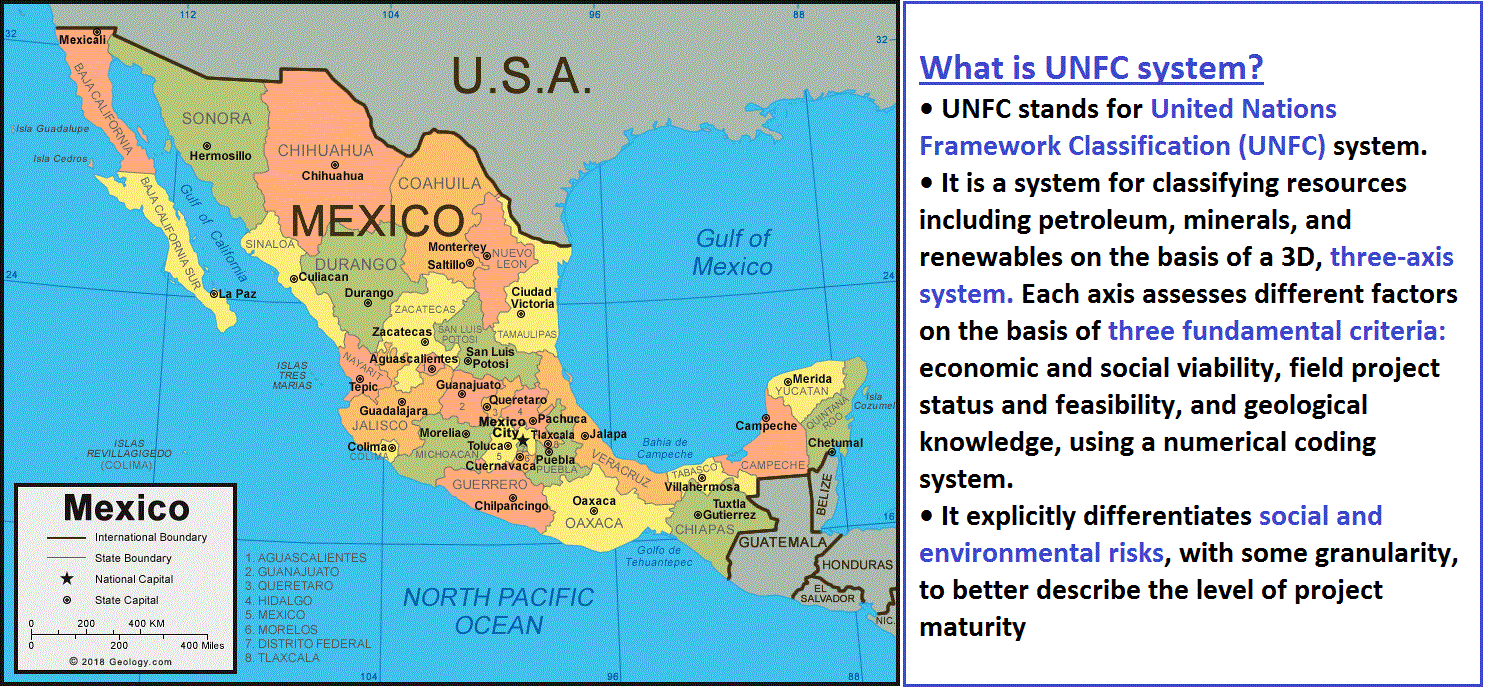
Challenges associated with the earlier system & the need to adopt for UNFC system:
- Earlier Mexico used to have the Petroleum Resources Management System (PRMS) as its official classification framework. It ignores the social and environmental risks associated with the oil and gas projects.
- In Mexico, a diversity of ecosystems exists, from deserts to regions rich in flora and fauna such as rainforests and wetlands. Also the country features a wide spectrum of cultures, indigenous identities, and social organizations. Without a proper multi-dimensional risk assessment, the industrial projects pose a great threat to aspects of life and biodiversity of Mexico.
- Hence there is a need for robust framework to assess social and environmental risks associated with the oil and gas projects.
Outcomes for Mexico from the adoption of UNFC system:

Where it can be used?
It can be used in topics related to Paper 1 (Sustainable development, Environmental degradation, and Energy crisis), Paper 2 (Industrialization, Energy Crisis, Sustainable growth) and GS 3 (Industrial Growth).
Sources:
Coonoor
|
Coonoor
|
|
Mon
|
|
Rairakhol
|
|
Chamundi Hills
|
|
Tarn Taran
|
|
Mutha River
|
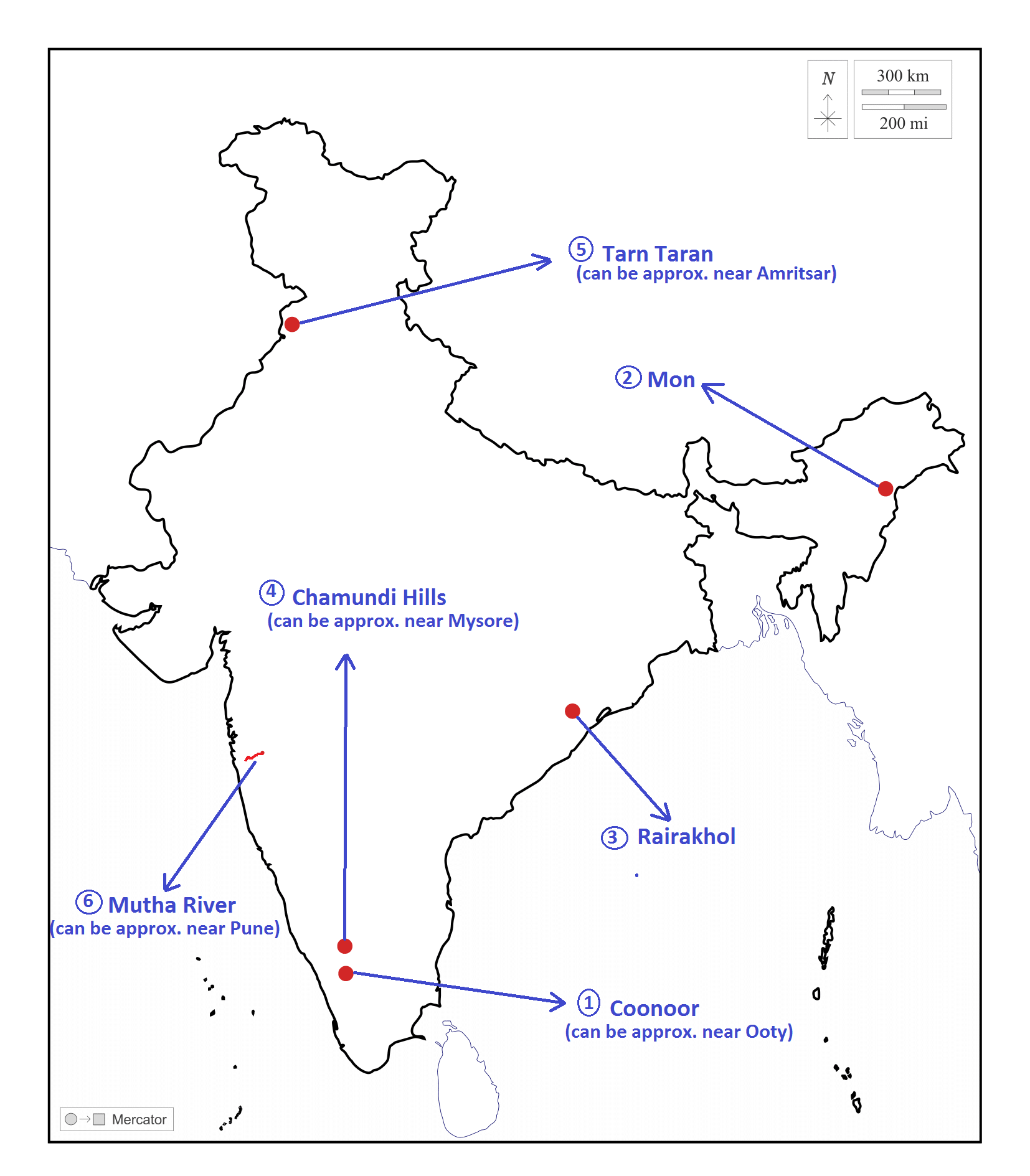
Share the article
Get Latest Updates on Offers, Event dates, and free Mentorship sessions.

Get in touch with our Expert Academic Counsellors 👋
FAQs
Geography Current Affairs focuses on the contemporary issues, events, and developments in the field of geography. It covers recent geographical phenomena, environmental changes, geopolitical shifts, and related news. This differs from regular geography studies which may focus more on foundational concepts, historical contexts, and theoretical frameworks.
Updates are provided regularly to ensure that subscribers stay informed about the latest developments in geography. Typically, updates are provided on a fortnightly basis, depending on the frequency of significant events and changes in the field.
Absolutely. Geography Current Affairs serves as a valuable resource not only for Geography optional but also for GS papers, especially GS Paper 1 (covering Indian Heritage and Culture, History, and Geography of the World and Society) and GS Paper 3 (covering Technology, Economic Development, Biodiversity, Environment, Security, and Disaster Management). It aids in building a holistic understanding of various topics and strengthens answer-writing skills by incorporating contemporary examples and perspectives.
Geography Current Affairs holds immense importance for UPSC preparation, particularly for aspirants opting for Geography optional. It helps candidates stay updated with the latest developments, geographical phenomena, environmental issues, and geopolitical shifts worldwide, aligning them with the dynamic nature of the subject as tested in the UPSC examinations.

